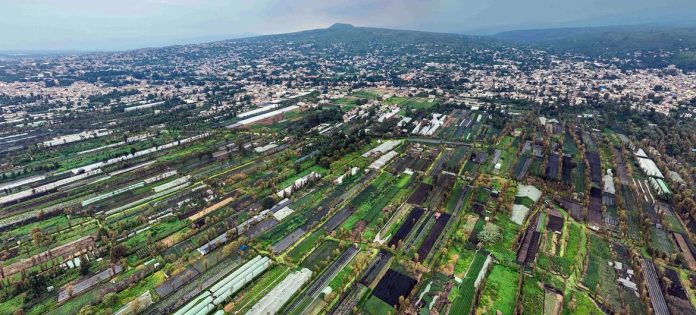In the heart of Mexico City, a centuries-old agricultural tradition is fighting for survival. The chinamperos of Xochimilco, farmers who cultivate crops on floating gardens called chinampas, have been sustaining the city for generations. But today, urban sprawl, environmental degradation, and climate change are threatening their ancestral way of life.
Ahead of the release of the 2025 Interconnected Disaster Risks report, a team from the United Nations University visited Xochimilco to hear firsthand how the chinamperos are working to preserve their heritage.
A Rich Agricultural Legacy
The practice of creating chinampas dates back to the Aztecs, who ingeniously layered mud, plants, and branches over shallow lake beds to form fertile floating islands. This system created a unique and sustainable method of farming, resulting in a sprawling network of nearly 180 kilometers of canals and gardens.
“I was born and raised in Xochimilco,” says Lauro Rivera, a 72-year-old beekeeper. “This place exists because of the hard work of our ancestors. They built the chinampas and anchored them with trees like the ahuejote. Their efforts still shape the land today.”
Modern Challenges for Ancient Traditions
While the chinampas once teemed with freshwater clams, fish, turtles, and axolotls, pollution and water scarcity have taken a toll.
“There were even freshwater clams here,” recalls Samuel Luna, a 67-year-old vegetable farmer. “Now we are trying to return to more eco-friendly farming methods with fewer pesticides. Maybe we can’t bring everything back, but we can preserve what remains.”
Today’s chinamperos, like Samuel’s grandson Eric Enríquez, are determined to continue the tradition, even as climate change makes farming unpredictable.
“You no longer know when it will rain or when it will be cold,” Eric explains. “Technology offers solutions, but not everyone can afford the necessary tools. Farming the chinampas is hard, beautiful work—and we can’t let it disappear.”
Preserving a Way of Life
The chinampa tradition is not only about food production but also about cultural identity. Mariana Cruz, a 29-year-old historian, highlights the vital role women have played in this heritage.
“My great-grandmother farmed the chinampas. She and many women worked alongside men to build this community,” Mariana shares. “There’s a stereotype that farming equals poverty, but we are proud to come from chinamperos. Their work is as vital as that of any doctor.”
She believes education is key to preserving Xochimilco’s importance, teaching others why protecting its canals, water systems, and agricultural legacy matters not just for locals but for the entire city’s future.
A Future in the Balance
The chinamperos stand at a crossroads. Without significant efforts to protect the environment, revitalize traditional farming, and attract new generations to agriculture, a vital part of Mexico City’s cultural and ecological heritage could vanish.
Their story is a reminder that sustainability, resilience, and respect for ancestral knowledge are critical—not just for the chinamperos, but for all communities facing the growing impacts of climate change.




